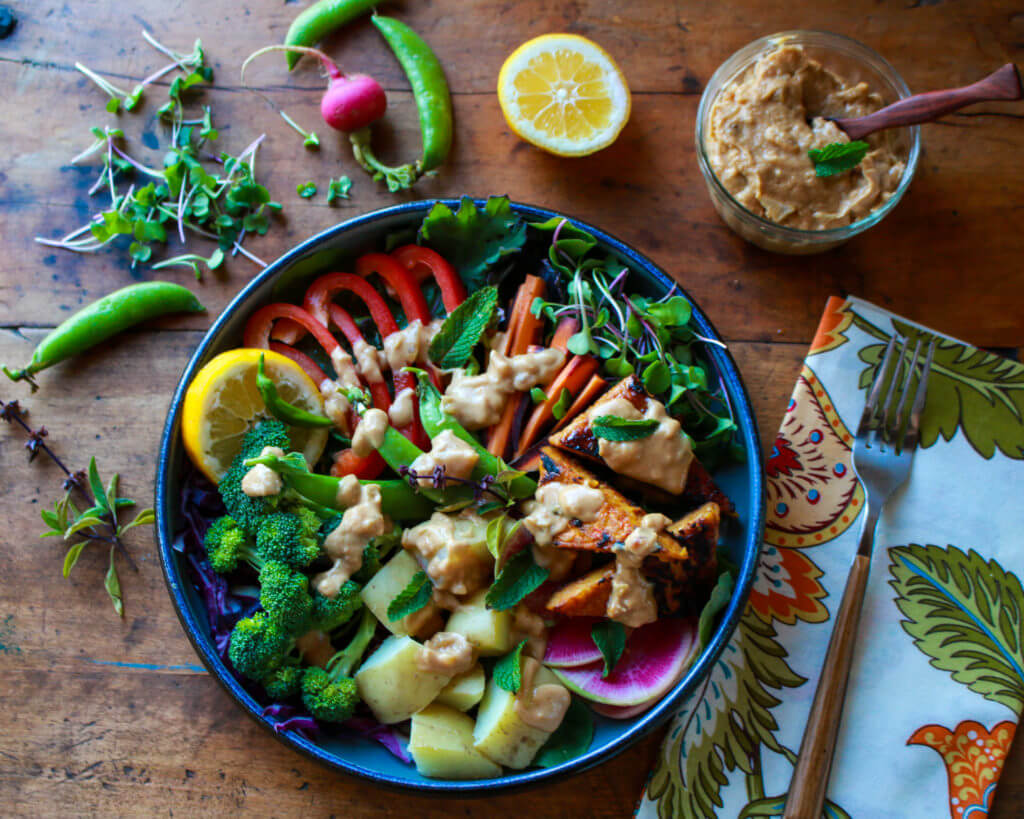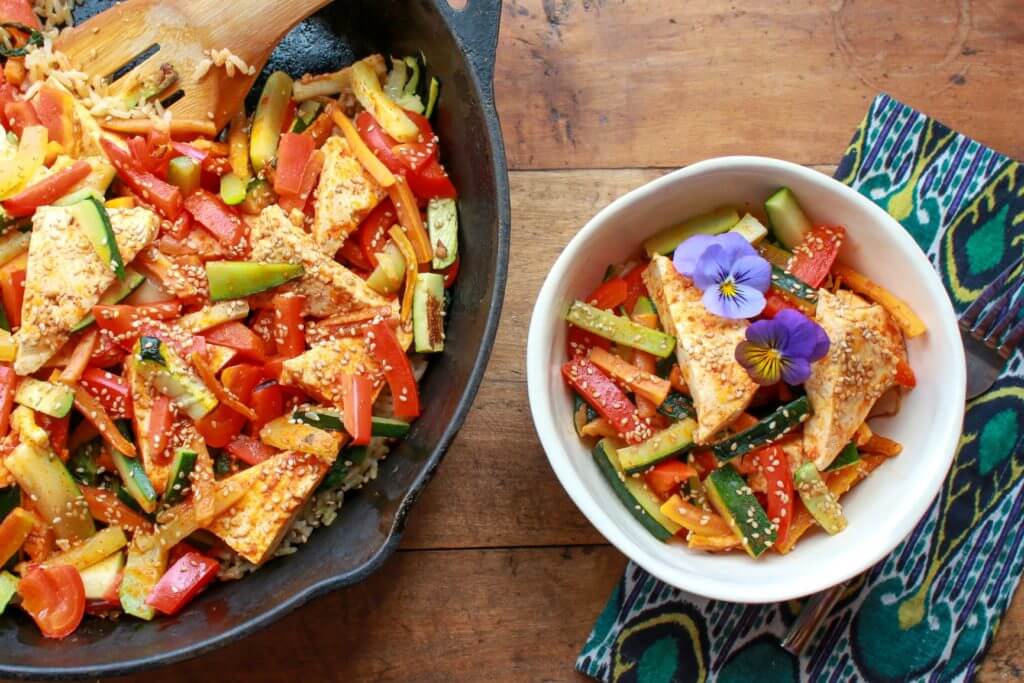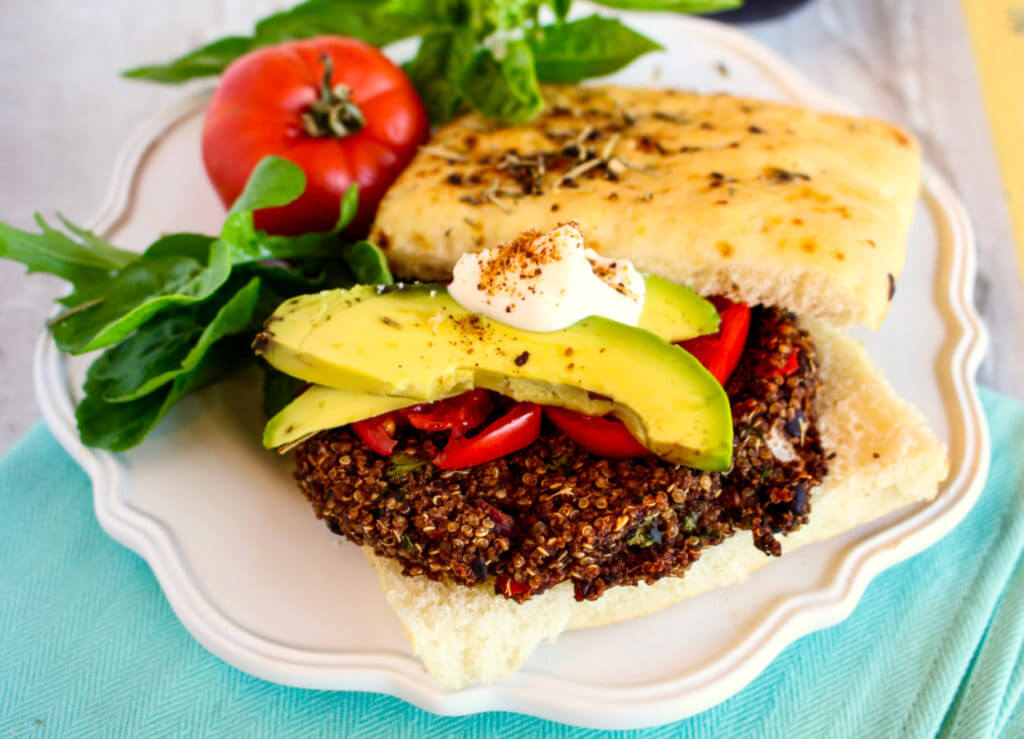Eat More Plants, Less Meat to Cut Carbon Footprint

Eat more plants and less meat to cut your carbon footprint. Tune in to these tips on how to move to a plant-based diet, no matter what your eating style.
If you’re thinking about how your diet impacts the planet, you might want to start with how much meat you put on your plate and how that affects your carbon footprint. It is interesting reading through this report that called for the developed world to cut meat consumption in half to reduce climate change. This makes perfect sense, as meat consumption has a huge impact on the planet. According to an Oxford University study, if everyone eliminated meat and dairy from their diet, it would reduce greenhouse gas (GHG) emissions from food production by an astounding 49 percent! And the thing is, we’re just eating so much of the stuff! So, we have room to cut back—even just a little bit. It’s not news that Americans love their meat. Many steakhouse menus proudly advertise a 16-ounce cut—a full pound of meat on your plate—and call their 8-ounce portion the “petite” serving. This oversized attitude toward meat also pervades backyard barbeques and home-style cooking. It’s sad that most home cooks usually plan their entire meal around animal protein. Indeed, according to the National Cancer Institute, the United States consumes meat at more than three times the global average. But what if we turned the tables and prioritized eating more plants on the plate?

Our meat-loving ways have accelerated over the years. Ask any octogenarian how they ate during their youth, a period marked by economic hardship and food scarcity, and they will probably tell you there was a lot less meat on the dinner table in those days. Meat was so precious, it was often reserved for Sunday dinners, and a small serving might be used to flavor a whole pot of beans for a meal. And they wouldn’t be exaggerating. Meat consumption has definitely risen over the years—it’s doubled between 1909 and 2007. According to the USDA’s What We Eat In America data sets published in 2018, the average American’s total meat (meat, poultry, and seafood) consumption in 2016 is 4.5 servings per day per person.

Why do we eat so much meat? Across the world, meat consumption is typically an indicator of economic wealth: As income levels rise, so does meat consumption. Despite a current shift toward higher poultry consumption in the United States, red meat is still the clear winner. Red meat (beef, pork, veal, and lamb) accounted for 51% of 2017’s 143.9-pound total, compared with 42% for poultry (chicken and turkey), and 7% for fish and shellfish.” The latest data shows women eat an average of 3 ounces of meat every day, while mean eat an average of about 5 ounces per day.
Time to Cut Back on Meat, and Push More Plants
So, what’s the big fuss about eating so much meat? Well, it looks like a high-meat diet—especially red meat and processed meat—is linked to health problems down the road. A number of studies has linked high intake of red meat, which includes beef, veal, pork, and lamb, with health problems, such as cancer, heart disease, and diabetes. In particular, the evidence is most compelling against processed meats, such as cold cuts, ham, sausage, hot dogs, and bacon. It looks like the negative effects of this type of diet could be caused in part by the presence of carcinogenic compounds in cooked and processed meats, and in part by the absence of health-protective plants typical of this way of eating. In fact, researchers from the National Cancer Institute report that, given the plausible scientific evidence linking red and processed meats to cancer and chronic disease risk, it might be time for us to reduce our read meat intake, and avoid processed meat altogether. The Lancet, a world-renowned scientific journal, published a report on the health and environmental benefits of reducing animal foods in the diet. For example, in the UK and Brazil, a 30% reduction in livestock production resulted in a 15% health gain and 10% reduction in mortality by 2050, due mostly to the reduction in red meat consumption. These benefits were associated with huge greenhouse gas reductions by 2050, around 80–90%.
Even in the recent past, meat wasn’t as plentiful or inexpensive as it is today—you can thank the advent of modern animal-agriculture practices for making meat so cheap in America. We’re churning out ground beef as efficiently as we fabricate clothes hangers, but we’re paying a heavy toll in inhumane animal conditions and less healthful food. As animals are confined, and fed diets they are unsuited for, they produce meat that is inferior in nutritional quality to that of pasture-raised animals. When cattle are allowed to roam in pastures and forage on wild grasses, their meat has a better fatty-acid profile than that of confined, grain-fed cattle. In addition, modern animal agriculture poses environmental concerns and food safety threats ranging from toxic manure lagoons that pollute local waters and spread of food borne pathogens to increased greenhouse gas emissions.

Eco-Impacts of a High Meat Diet
If you cut back your animal food intake, you can make a big impact on planet Earth and reduce your carbon footprint. Each year we eat billions of pounds of meat and drink billions of gallons of dairy products from billions of animals. In doing so, we not only contribute to inhumane animal practices, but we are responsible for the use of large amounts of chemical pesticides and fertilizers to produce animal feed, as well as large volumes of water and fuel to take animals to market. Byproducts of animal food production include greenhouse gas emissions, toxic manure lagoons, deforestation, and pollution of groundwater, rivers, streams, and oceans. According to an analysis conducted by CleanMetrics for the Environmental Working Group, greenhouse gas emissions generated by conventionally raising lamb, beef, cheese, pork, and farmed salmon—from growing the animals’ food to disposing of the unused food—far exceed those from other food choices like lentils and beans. Most of the Greenhouse Gas (GHG) emissions produced by the food industry are not from transportation of the food, but from the farming process itself. Cattle raised for beef produces more than 75g CO2eq (carbon dioxide equivalent) and uses more than 60x the amount of land to make 100g of beef vs. less than 5g CO2eq from producing 100g of tofu. Even other meats are small GHG producers in comparison, with lamb and mutton second in the top GHG ranking, producing about 30 kg CO2eq to produce 100g worth.
In our culture of climbing obesity rates, it should be a wake-up call to remember that one billion people around the world don’t have enough food to eat right now. And just think how much tougher it will be to feed the world in 2050, when there will be 9.7 billion people living on the planet. At the same time, our current agricultural practices and diet patterns are unsustainable. But environmental experts agree on one important principal that could increase the world sustainability of food for the long haul: Growing animal feed on prime croplands, no matter how efficiently, is a drain on the human food supply. Dedicating croplands to direct human food production could boost calories produced per person by nearly 50 percent, according to a report from researchers from Canada, the United States, Sweden, and Germany.
According to the Environmental Working Group, eating less meat can significantly reduce your carbon footprint, which is the total greenhouse gas emissions produced from your activities. Here’s how your eating less meat will measure up in climate-saving action over one year and cut your carbon footprint.
- If you eat one less burger a week . . . It’s like driving 320 miles less.
- If your four-person family skips meat and cheese one day a week . . . It’s like taking your car off the road for five weeks.
- If your four-person family takes steak off the menu one day a week . . . It’s like taking your car off the road for almost three months.
- If everyone in the United States ate no meat or cheese for just one day a week . . . It would be like driving 91 billion miles less, or taking 7.6 million cars off the road.
A recent University of Oxford study showed that cutting meat and dairy from your diet could lead to 76% less land used for food production and a 49% reduction in ecosystem pollution from fertilizers.

Save the Planet!
You can seriously reduce your carbon footprint by eating fewer animal foods, according to a number of studies. Italian researchers performed a life-cycle assessment to evaluate the cradle-to-grave environmental impact of several dietary patterns. They discovered that an organic vegan diet had the smallest environmental impact, while a conventionally farmed diet that included meat had the greatest impact on the environment—and the more meat consumed, the greater the eco-impact. They also discovered that beef was the food with the single greatest impact on the environment; other high-impacting foods included cheese, fish and milk. In essence, animals make inefficient “food production machines,” using up lots of feed, water, and fossil fuels to turn plants into protein. To produce 1 calorie from beef requires 40 calories of fossil fuels, whereas producing 1 calorie from grains requires only 2.2 calories of fuel. Plant-based diets can play an important role in preserving environmental resources and in reducing hunger in poor nations.

So, if you’re considering making a goal to lighten your carbon footprint this year, make a simple pledge: cut back on meat, whether you do Meatless Monday, go semi-vegetarian, or even vegetarian or vegan. You can make a difference!
For other blogs on sustainability, check out these:
Eat for the Environment
Kitchen Recycling 101
Top 11 Tips for Sustainable Eating
Written by Sharon Palmer, MSFS, RDN on April 22, 2014; Updated on July 13, 2020.
Image: Heirloom Bean Cassoulet, Sharon Palmer, MSFS, RDN


